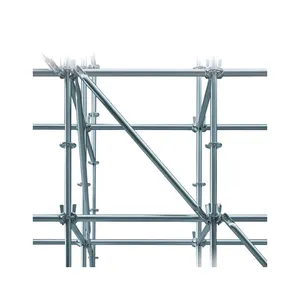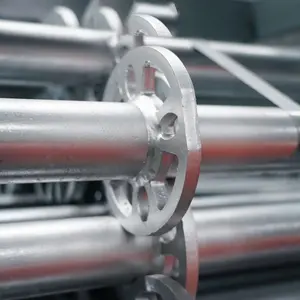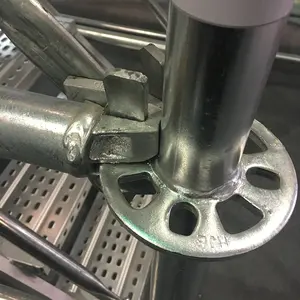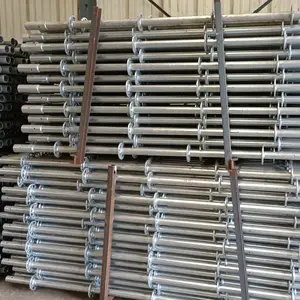(1341 products available)































































































































































































Layher scaffolding accessories are components that enhance the performance, safety, and functionality of scaffolding systems. These accessories come in different types, including;
Couplers
They are also known as clamps. Couplers connect two or more scaffolding tubes, creating a framework. Layher manufactures various types of couplers, including rosettes, swivel couplers, fixed couplers, and joint pins.
Decking
These are platforms that support workers and materials. Scaffolding decking comes in different designs, including steel anti-slip decking, plywood decking, and aluminum decking.
Base Plates
Base plates are large metal plates. They are located at the end of each scaffolding standard. Base plates distribute the weight of the scaffolding and the load it carries to the ground. They provide stability to the scaffolding structure.
Jacks
Jacks are adjustable devices. They are attached to the bottom of scaffolding standards. Jacks support base plates and adjust the height of the base plate to ensure the scaffolding is stable on uneven ground.
Guardrails
These are rails that run along the side of the scaffolding. They prevent workers from falling off the edges. Guardrails consist of top rails, mid-rails, and toe boards.
Braces
Braces are triangular metal rods. They increase the rigidity and strength of the scaffolding. Scaffolding braces prevent the structure from swaying and collapsing.
Hooks
Hooks are L-shaped metal accessories. They connect and support scaffolding components, such as planks and ladders. Scaffolding hooks enhance the accessibility and safety of the structure.
Ladders
Scaffolding ladders provide a safe way for workers to access different levels of the structure. They are made of strong materials like aluminum and steel. Ladder accessories include safety cages and ladder stabilizers.
Blinking
Scaffolding blinking are wooden or metal beams. They support scaffolding decking and ensure the workers are safe. Blinking consists of single blinks, double blinks, and end blinks.
Suspension Accessories
Suspension accessories convert scaffolding into suspended scaffolding. They include hoists, rigging equipment, safety locks, and suspension cables.
Scaffold Fittings
Scaffold fittings are small components that help in assembling and disassembling scaffolding. They include socket fittings, scaffolding pins, and spanner keys.
Scaffolding accessories are important in the construction industry. Their main function is to provide support to construction personnel and materials during construction projects. Scaffolds are the temporary structures that hold and support construction workers, materials, and tools. They are used to give workers a safe platform to perform their duties, especially when working on elevated areas. Scaffolding accessories are crucial components of the scaffolds. They ensure safety, stability, and structural integrity when they are fitted to scaffolds.
Scaffolding accessories come with various features that influence how they function. Some of the features include:
Scaffolding accessories are critical components in construction. They help in providing safe and stable platforms for construction workers when working on elevated areas.
Layher scaffolding accessories are used in various scenarios to improve the safety and stability of scaffolding structures. Here are some common usage scenarios:
Support of Scaffolding Joints
Scaffolding accessories are primarily used for the reinforcement and support of scaffolding joints. They ensure the structural integrity of the scaffolds by distributing loads evenly. This reduces the risk of joint failure. The accessories provide additional support to joints in complex or high-rise scaffolding configurations. This enhances stability and load-bearing capacity.
Enhancement of Brace Stability
Braces are an important component of scaffolding. The accessories are used to improve the stability of scaffolding braces. For instance, the use of tension cables and diagonal bracing systems provides a robust and rigid framework. This is especially useful in windy or high-load conditions. Additionally, the accessories maintain the alignment of the braces. This minimizes lateral movement and sway of the scaffolding structure.
Safety & Guardrails
Scaffolding safety accessories ensure the safety of workers. They include guardrails, toe boards, and safety nets. The guardrails create a protective barrier. This prevents workers from falling off the scaffolding platform. They are especially important in high-rise construction projects. The safety accessories also prevent tools and materials from falling off the edge. This minimizes the risk of injuries caused by falling objects.
Connections and Couplers
The connections and couplers allow the reliable and quick assembly and disassembly of scaffolding. They provide a flexible and secure connection between individual components. This facilitates the construction of complex scaffolding configurations. The accessories also accommodate different angles and joints. This provides customized solutions for various construction projects.
Platform Accessories
These accessories improve the functionality of the scaffolding platforms. They include anti-slip boards, platform brackets, and decking systems. The platform accessories create a safe and stable working surface. They enhance accessibility and reduce the risks of slips and trips. The accessories also improve the durability of the platform. This reduces maintenance costs and improves the overall cost-effectiveness of the scaffolding.
When purchasing accessories for scaffolding, it is important to consider various factors to ensure safety and efficiency at the construction site. Here are some important factors to consider:
Regulations and Standards
All accessories should meet the local and international safety standards and regulations. These regulations are put in place to ensure that all accessories are safe for use in construction.
Material and Durability
Assess the quality of the material used to manufacture the scaffolding accessories. Choose scaffolding accessories that are manufactured with high-quality materials like steel. High-quality materials ensure that the accessories are stable and can support a range of weights. Additionally, the materials should be able to withstand harsh environmental conditions like extreme weather and corrosion.
Compatibility
The scaffolding accessories should be compatible with existing components. This ensures that the entire scaffolding system functions optimally. Additionally, compatibility enhances safety as it ensures that all components work together without failing.
Type of Project
The type of project significantly influences the selection of scaffolding accessories. For instance, a project that requires support on a tight timeline may require modular scaffolding due to its quick assembly and disassembly features. Additionally, the accessories needed for a high-rise building are different from those required for a small structure.
Supplier Reputation
It is important to purchase scaffolding accessories from a reputable supplier. A good supplier delivers quality products and provides excellent customer service. Additionally, a reputable supplier offers products at a fair price and delivers them on time.
Ease of Use and Maintenance
Buy accessories that are easy to install and require minimal maintenance. This reduces the overall cost of the project and saves time. Additionally, these accessories enhance the overall safety of the project since they don't require complex installation procedures.
Cost
Although it is important to consider the cost of the accessories, it should not compromise quality. Choose layher scaffolding accessories that are affordably priced but offer high-quality support. This ensures that there are no additional costs incurred due to accidents or premature failure of the accessories.
Q1: What are the weight limits for Layher scaffolding accessories?
A1: Weight limits depend on the type of accessory and the configuration. Consult load charts for specific limits.
Q2: Are Layher accessories compatible with other scaffolding systems?
A2: Compatibility varies by accessory. It's best to use Layher components with other systems to ensure safety.
Q3: How are scaffolds equipped with outriggers maintained?
A3: Regular inspections are required to check for structural integrity. Components should be replaced if they are worn out.
Q4: What type of training is needed to use Layher accessories?
A4: Users should undergo training on scaffold assembly, operation, and accessory-specific usage. This will promote safety and compliance.
Q5: Can scaffolds be erected without outriggers?
A5: Scaffolds can be built without outriggers if the structure is stable and meets safety guidelines. However, outriggers are often needed to enhance stability, especially on uneven ground.